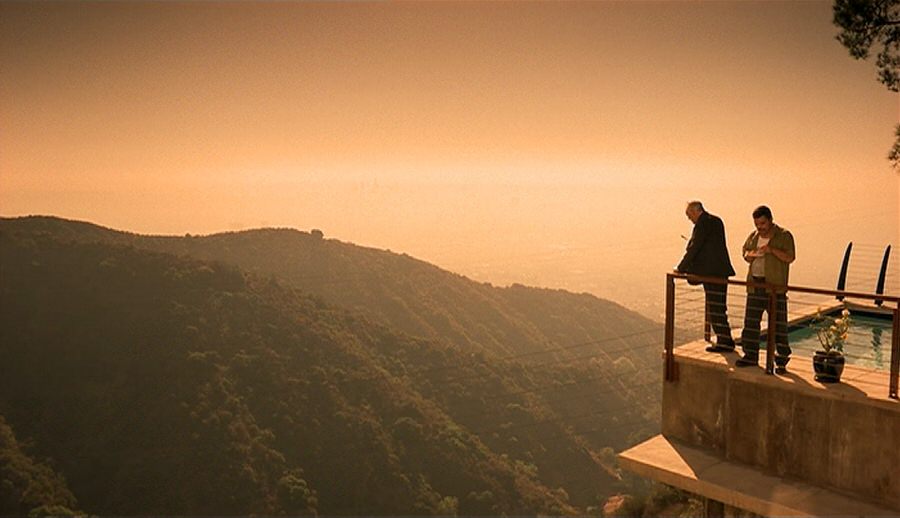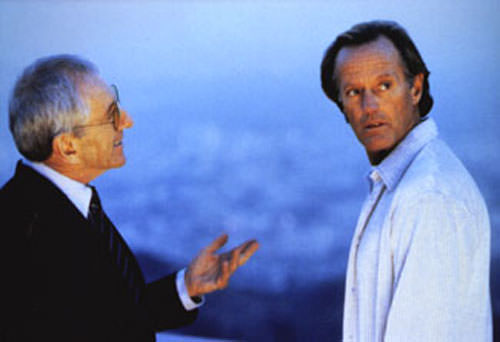The Limey
Directed by Steven Soderbergh (1999) ***1/2
In what could double as a master acting class given by British actor Terence Stamp, Steven Soderbergh’s The Limey is a taut, propulsive thriller which lost seven million dollars at the box office, but was critically lauded at the time and has been even more so since.
 Stamp is Wilson, a crook who has spent years in prison for helping to steal the receipts of a Pink Floyd concert. A career criminal, he’s now on his way to L.A. to investigate the death of his daughter, Jenny (Melissa George), who mysteriously died in a car accident. Wilson suspects the death was murder and has vowed revenge on the perpetrator(s). This stock plot could have been executed as routinely as a Liam Neeson vehicle, but Soderbergh, screenwriter Lem Dobbs (Dark City) and editor Sarah Flack (Kafka) find the subtleties and complexities of all the characters involved, sometimes using innovative and memorable techniques.
Stamp is Wilson, a crook who has spent years in prison for helping to steal the receipts of a Pink Floyd concert. A career criminal, he’s now on his way to L.A. to investigate the death of his daughter, Jenny (Melissa George), who mysteriously died in a car accident. Wilson suspects the death was murder and has vowed revenge on the perpetrator(s). This stock plot could have been executed as routinely as a Liam Neeson vehicle, but Soderbergh, screenwriter Lem Dobbs (Dark City) and editor Sarah Flack (Kafka) find the subtleties and complexities of all the characters involved, sometimes using innovative and memorable techniques.
Wilson first tracks down Jenny’s friend Eduardo (Luis Guzmán), who had alerted Wilson to Jenny’s death. The two become an oddly matched investigative team. Wilson also enlists the aid of Jenny’s friend Elaine (Lesley Ann Warren). The Limey is smart enough to not allow Wilson and Elaine a romantic angle.
 All clues lead to record producer and part time drug money launderer Terry Valentine (Peter Fonda), Jenny’s boyfriend at the time of her death and a rich ex-hippy ensconced in a luxurious mansion in the L.A. hills. Fonda is just great in the part, a reminder of his often neglected or forgotten talents. He was, for my money, in some ways a better, more naturalistic actor than his more famous father. Valentine’s right-hand man, Avery, is performed by the so underused Barry Newman; Avery, the go-between who finds and hires muscle, is smarter than his boss, though no less safe from Wilson’s slow-burning onslaught.
All clues lead to record producer and part time drug money launderer Terry Valentine (Peter Fonda), Jenny’s boyfriend at the time of her death and a rich ex-hippy ensconced in a luxurious mansion in the L.A. hills. Fonda is just great in the part, a reminder of his often neglected or forgotten talents. He was, for my money, in some ways a better, more naturalistic actor than his more famous father. Valentine’s right-hand man, Avery, is performed by the so underused Barry Newman; Avery, the go-between who finds and hires muscle, is smarter than his boss, though no less safe from Wilson’s slow-burning onslaught.
A high point of The Limey is a sequence so perfect it could be taught in film schools, wherein Wilson and Eduardo discreetly crash a party Valentine is giving for Hollywood insiders and hangers-on. The tension and menace of the hunt for clues is acute, and violence, when it does take place, is inventively shot obscurely, from afar and from Valentine’s worried point of view.
Dobbs’ screenplay, which was pared down substantially by Steven Soderbergh for an hour and a half film (much to Dobbs’ consternation), bequeaths a breath of life to all the side characters involved. Henchmen who would be cliched ciphers in most films of the like are here free-thinking, opinionated, sometimes funny and always entertaining. A DEA agent (Bill Duke) is played as a blasé, seen-it-all career man. Wilson himself, while no one to mess with, is a more nuanced ex-con than we’re used to seeing.
Soderbergh, daringly, uses as a technique to represent Wilson in his youth, and flesh out his backstory, footage of Stamp from director Ken Loach’s feature film debut, Poor Cow (1967). The young footage of Stamp is believably incorporated into The Limey‘s story. Also propelling the plot and keeping the audience on its toes is the editing in which past, present and future frequently overlap, both aurally and visually. Memories are accented by a novel use of lighting, and the L.A. sun, what it reveals, highlights and obscures, nearly becomes a character in its own right. Well-chosen 1960s and ’70s songs also contribute to the mood.
The Limey most likely didn’t “sell” because U.S. audiences weren’t interested in a film about older people, but the older people who made this film still had it.
—Michael R. Neno, 2022 Apr 19